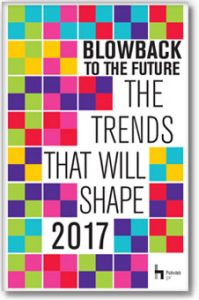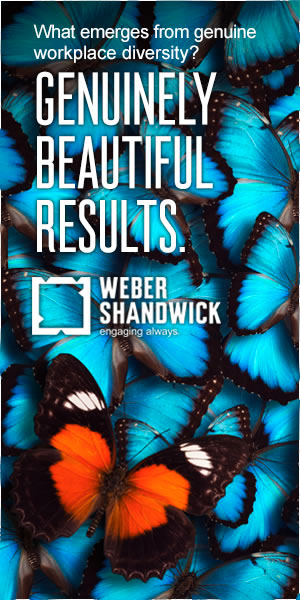From confused women and men to boiling points, the 2017 Insights report from the Havas PR team covers the top 17 trends for 2017. To download the report, click here.
DIVERGE spoke to Marian Salzman, CEO of Havas PR to find out about the trends and more:

Why did Havas release this report and why is it important to focus on these trends?
If you can read the tea leaves, you can ensure your clients can live our mantra: be the news.
The ability to look for random patterns and extrapolate from the past and present—the basic element of trendspotting—is hardwired into the human brain for survival. Yet, for most of human history, people lived in small groups and not a lot changed from one decade to the next. Year in, year out, the same people performed the same activities in the same places, with the occasional unpredictable catastrophe. Now, of course, the most fundamental truth of what’s next (besides death and taxes) is unprecedented change. Those who stay ahead of or on top of these changes, those who can surf them and communicate them to a broader group, will be the winners within their industries and within the world at large.
So what exactly is trendspotting? Let’s break it into two co-dependent parts. Part one is the defining of trends: being able to pick out and label short-term manifestations involving fashion, design, or new waves of thinking that leave lingering impact, or long-term shifts. Trends should have relevance for 10, 20, even 30 years—the Future Headlines, as I call them—such as the “ations”: individualization, globalization, hyperlocalization, digitalization, miniaturization, etc.
Part two is the packaging of the predictions, which is probably where most great trendspotters make their mark (#namethattrend). Trends (read: predictions) are what fuel the story of the future; they are our hunch about where we believe or hope we’re headed.
As a trendspotter (for me, that’s a job attribute rather than a profession), I plunge in headfirst, talking face to face with trendsetters and recruiting them to work alongside the brands we consult with, to provide upfront and personal feedback. I have married that with routine quantitative studies, always searching for the numbers that pop from the data sets, to help me start painting a story of new directions in consumer attitudes, beliefs, values, and brand and media preferences. Then and now, it is about identifying when and where to anticipate change—and to invent desire. My personal style of trendspotting is sociological and exudes the media savvy that comes along with a top job in marketing and communications. It combines the generation of ideas that comprise consumer marketplaces and marketspaces with the partnering of the press and mass media to spread those ideas.
In this age of linchpins and polyglots, in the parlance of Seth Godin, the best trendspotters are many things to many people—equal parts participant, travel agent, eBay bidder, flea market digger, scavenger, voyeur, journalist, food shopper, clotheshorse, anthropologist, sociologist, intuit and forensic investigator.
Being a trendspotter is a label that comes with many sub-labels that all contribute to an ability to really “see” things when others are just looking at them. In my case, those sub-labels include all of the above, plus activist, author, blogger, brand marketer, globalist, localist, news nut, philanthropist, publicist, social media junkie, strategist and volunteer.
Elaborate on ‘Fighting Mad.’
2016 marked the high point (so far) of the echo-chamber trend, our marked tendency to huddle together with similar people and share similar ideas online. Idealists imagined the internet as a space where people who had differing beliefs and opinions would find each other, share their ideas and, hopefully, learn from each other. It was to be a space where folks who normally wouldn’t have the opportunity to meet and converse with each other would be able to do just that. It hasn’t quite worked out that way. Even though a diversity and plurality of insights and opinions is only a click away, nobody is listening to anyone with a different POV.
Let’s face it, we all have a natural—even if at the same time fatalistic or counterproductive—tendency to seek out others whose opinions and lifestyles mirror our own. We are instinctively drawn to those who we are most like. In turbulent times, we seek antidotes to fear and familiarity makes us feel safer. We feel united to something when there are thousands of others echoing our sentiments, virtually cheering us on to keep fighting the same fight they are.
When that fight is won, it’s the power of people coming together to affect change. Where we lose is that we haven’t changed, we haven’t embraced anyone’s differences or worked with anyone to find more all-around beneficial solutions. This ego-feeding tactic can serve us poorly in our personal lives and it’s likely to be disastrous in our professional lives. Would-be influencers who can resist the power of the dark side and start engaging with and seeking out other voices will surface as winners within their industries.
While we’re still on Uneasy Street—our 2016 Übertrend—successful brands will surround their customers with connectivity. Consumers drenched in uneasiness respond to brands that give them a sense of comfort and familiarity. In late 2010, we flagged that people were “mad as hell—and only getting madder,” and so it went. 2016 brought us the Brexit vote in the United (for now) Kingdom and the election of Donald Trump in the United States. Pushback against easily defined targets of anger can be coordinated by well-defined interest groups. Look to Airbnb’s recent expansion of its efforts to help regulate house rentals in cities where the hotel industry is feeling the pinch as an example.
And, since people are more energized to act against what they don’t want than for what they do want—while anger can energize people, happiness can feel like a great meal that satiates us and then makes us sleepy—blowback on a large scale won’t be pretty. Even when the source of innovation and change is broader or not so easily pinpointed, the sense of “enough already” is there to be harnessed by astute commercial, social or political entrepreneurs. Look for many more of these pushback-savvy communicators to emerge as examples of change hit the headlines and the energy of “enough already” spreads.
What were some of the surprising/new trends?
When it comes to how we present ourselves and define our roles and identifies as men and women, the last year has left some questioning if we even know who we are or how we want to be seen. Thirteen years ago, we called out metrosexuality, and two years later came the übersexuals. Then, around 2010, came two schools of retrosexuals—the clean-cut, sharp-suited “Mad Men” throwback look and the flannel-shirted-styled-beard-wearing hipsters. To top it off, Mark Zuckerberg all but invented a new workplace underdress code when he showed up to meet IPO investors in a hoodie back in 2012. Four years later, those Don Draper–esque dressers are almost relics at the office. These days, a man wearing a vest or an open-collar dress shirt is likely to stand out more than an intern in shorts and flip-flops. The big trend driving all this: men’s underlying anxiety about what is manly now and who the heck decides is putting the malleability of manhood to the test.
Meanwhile, women are trying to decide what’s going to be on the next new feminist agenda. Because we are now talking about sexism more openly and freely, we are seeing—I am seeing—things that would have been written off before as “Boys will be boys” as more fundamentally sexist. And we’re calling the guys out on their misbehavior. At the same, when it came time to cast our votes last November, a stunning majority of us effectively shrugged and mansplained our way to a president-elect who unabashedly believes in a boy’s right to misbehave. There’s a strong, around-the-world growth of voices casting out feminism as old-fashioned or even obsolete. Channeling and harnessing that disruptive energy, women are calling for the right to self-determine their feminism and for their right to return to the gender roles of an earlier time, if they so choose.
Confusion will only grow in 2017, as women continue to debate—internally and with the world—what they expect and what they feel is rightly expected of them. How women align, balance and reject those answers will form a rolling, ongoing dialogue with millions of voices pitching in online and off.
How will these trends affect the PR industry in 2017?
“An ever-shifting communications landscape has brought seismic changes to public relations. These days, being nimble about the news—knowing all the ways it reaches audiences and knowing how to craft it—is the name of the game. Over the three decades I’ve spent in and around this industry, PR has evolved: It used to be all about having, then selling, the idea. Now it’s about telling the story in a compelling and believable way. In order to survive, PR has had to become the most agile of the communication arts.”
So begins our new book, Agile PR: Expert Messaging in a Hyper-Connected, Always-On World, a tell-it-like-it-is primer on modern public relations. Since our industry today is almost nothing like it was five years ago, the updated perspective was sorely needed.
As PR’s ethical standards, its anticipated outcomes and its very definition have shifted beneath our feet, I’ve come to understand that one thing will always remain true: the future of PR is the future of news. And understanding the 24/7/365 nature of the news is the best way for PR practioners to craft news that others will want to participate in. For anyone who doubts the importance of crafting the news, consider that public relations accounts for 10 to 50 times as many conversions as advertising. But traditional PR is just one tool in a kit that also includes social media, brand journalism, content marketing and even native advertising. A few years ago, we had heard of very few of these practices; now we must be fluent in all of them—and in whatever is coming next. Along with the 17 trends featured in our new report, Blowback to the Future: The Trends That Will Shape 2017, here are five additional trends that are specific and intrinsic to news and PR:
• Celebrities aren’t just spokespeople anymore. They’re their own brands. Think Jessica Alba’s Honest Company. So when a brand chooses a celeb, they aren’t just hiring the person as a short-term shill—but blending the celeb’s brand with their own. And what happens when journalists become celebrities in their own right? We also need to rethink who the influencers really are (hint: not just mainstream media and celebrities).
• Taboos will go mainstream. Today, everything and anything is fair game; why else would The New York Times feature stories on how women runners relieve themselves? Death, menstruation, urine—all now appropriate for print and ready to be hijacked by savvy newscrafters. PR pros can push boundaries a little further than we used to in telling stories.
• Audiences will want more life hacks and simple pleasures. Watch those one-minute cooking videos sprouting in your Facebook feed. In the year after BuzzFeed launched Tasty, it amassed more than 53 million Facebook followers and became Facebook’s most-watched video publisher. This fuss-free publishing concept also plays into our collective desire for simple pleasures like food porn and our interest in life hacks. And it helps that these videos run on auto-play, another trend for marketers to note: Make things as easy as possible.
• Brand journalism is about to become a much bigger deal. That means hiring former journalists for their storytelling abilities and expecting them to stay positive but also encouraging them to actually think like journalists. Brand journalism isn’t just telling good stories but also identifying and researching those stories—and that means giving brand journalists full access to clients so that they can use their skills to hone in on positive news that can reinforce a brand and flip negative news on its head.
• Media relations gets a makeover. Once a pillar of PR, media relations now begs the question: How can we perform media relations when we don’t know who the media even is anymore? Or rather, everyone is the media, now that we live in an age when a single tweet can catch fire and a YouTube star can debut overnight. So if you buy into the idea that media relations is a relic, then the job of a great PR leader now incorporates so much more: strategic branding, content marketing, channel agnosticism, even native advertising.
PR will never let us get too comfortable. It requires a certain intellectual acuity and the ability to move forward fast, skip around obstacles, change direction without losing momentum and stop on a dime. We call it “agile” for a reason.
Were the trends for 2016 on point?
Unfortunately, we were dead right and the trends of anger and uneasiness elected our next president. What can I say? I wish I had been wrong, that our multicultural society would have found the next Barack Obama and supported her (or him) with the same hope we felt in 2007/2008. Before Uneasy came anger and clearly America’s transformation from white and male to a rainbow and dual gender and everything in between has left Joe Sixpack and his female partner ticked off and playing dirty… Sorry, I don’t like confusing my own progressive perspective with the trends I see, but this past year or so has challenged my capacity to chew on my lip.
Are diversity and inclusion on the trends/points for 2017?
For years, your everyday Joe Sixpack American has watched the idea of masculinity shift and sway in the cultural winds, upending his sense of identity, his understanding of his place in his country’s culture. The only thing constant about the perception of masculinity over the past few decades has been its mercurialness.
From a trendspotting point of view, this is fascinating stuff. To the binary male in the Rust Belt, this malleability of manhood is at best annoying, at worst the source of an underlying anxiety: What constitutes manliness now, and who the heck decides? More and more, Joe Sixpack saw “not me” as the answer to the latter, and clearly, being left out of that discussion didn’t sit well.
Enter Donald Trump, with his rejection of polish and politeness and willingness to unabashedly cast Baby Boom gender roles in rosy hues. Trump gave Joe Sixpack not just a voice, but a brash, bold bullhorn. (Incidentally, when I counted Trump among the ultimate übersexual examples, he thanked me.) If you asked Sarah Palin—long a big Joe Sixpack cheerleader—Trump isn’t just an advocate for your American everyguy, he’s the best of Joe Sixpack writ large. “He’s got these Joe Sixpack issues on his mind, and he’s got these Joe Sixpack common sense solutions,” she said while stumping for Trump. “He just happens to be an extremely successful and charismatic, with a very large platform, Joe Sixpack.” When it comes to nontraditional masculinity, Fox News Radio host Todd Starnes said conservative voters were clear: They “want a pit bull in the White House, not one of those metrosexual purse dogs.” Ouch, Metrosexual Man—that’s a kick in the bespoke pants.
So we saw men expressing their frustration, despair, anger and, yes, rebellion by tapping a touch screen to vote, in part for returning to the gender roles that are emblematic of when America was “great.” Trump beat his opponent—a woman very much removed from traditional gender roles—by 12 percentage points with men. (For comparison, George W. Bush, who played demonstrably strong with men, only notched an 11-point lead in 2000 and 2004.) To be fair, Jane Sixpack and her urban Jane-Growler-of-craft-beer peers are grappling with gender-role upheaval, too. Women are pushing toward a quicker draw against sexist behavior, and at the same time, wondering whether feminism’s main tenets can include freedom to re-embrace the gender roles of their grandmothers. In 2017, that confusion will only grow, as women define what they expect and what they feel is expected of them, and balance their answers in a roiling, ongoing dialogue. As much as the headlines heralded Trump’s rise as “stunning,” “shocking” and, well, “unpresidented,”we can’t say we didn’t see upheaval coming. Last year, we forecast a rise in “unease” that’s clearly played out across all kinds of borders. And 2016 bore out another trend we sighted in late 2010: People are “mad as hell—and only getting madder.”
Our expectation, as the disruption settles into place: more blowback, more pushback and more “enough already” on the horizon. What’s the message that astute commercial, social or political entrepreneurs can take from this, as we communicate with the confused men, the confusing women, masses of people in a state of “unease”? People are feeling more energized to act against what they don’t want than to push for what they do want. So we’re looking to speak the language of rebellion: channeling and harnessing that disruptive energy.
Marian Salzman is CEO of Havas PR North America and chairman of the Havas PR Global Collective. Her latest book, Agile PR, will be published by AMACOM in January 2017.

